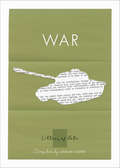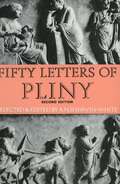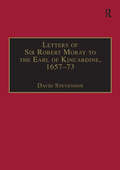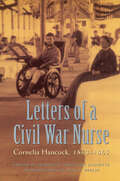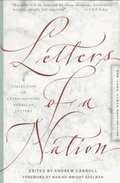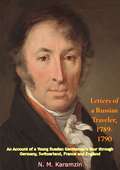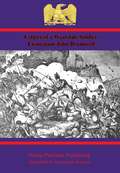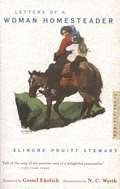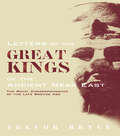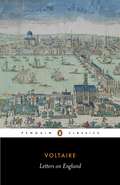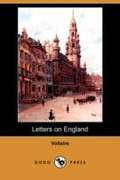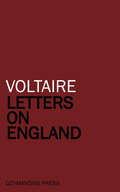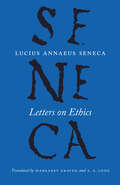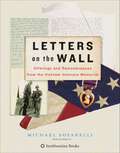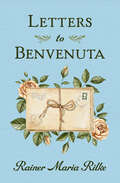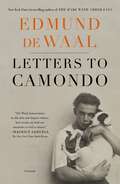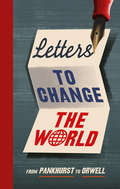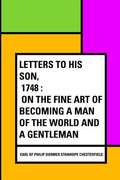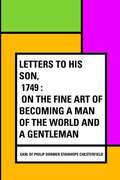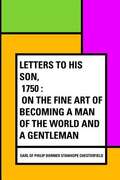- Table View
- List View
Letters of Note: War (Letters of Note)
by Shaun UsherA compilation of remarkable letters with love at their heart, from the curator of the globally popular Letters of Note website.The first volume in the bestselling Letters of Note series was a collection of hundreds of the world's most entertaining, inspiring, and unusual letters, based on the seismically popular website of the same name--an online museum of correspondence visited by over 70 million people. From Virginia Woolf's heartbreaking suicide letter, to Queen Elizabeth II's recipe for drop scones sent to President Eisenhower; from the first recorded use of the expression 'OMG' in a letter to Winston Churchill, to Gandhi's appeal for calm to Hitler; and from Iggy Pop's beautiful letter of advice to a troubled young fan, to Leonardo da Vinci's remarkable job application letter. Now, the curator of Letters of Note, Shaun Usher, gives us wonderful new volumes featuring letters organized around a universal theme.In this volume, Shaun Usher turns to the subject of love. What emotion inspires humans to put pen to paper more than love? It's unsurprising that love letters provide an endless source of extraordinary writing. Letters of Note: Love gathers together some of the most powerful messages about love ever composed, whether inspired by love's first blush or the recriminations at its ending, the regrets of unrequited feelings and the joys of passions known. Includes letters by Zora Neale Hurston, Napoleon Bonaparte, Frida Kahlo, Nelson Mandela, and many more.
Letters of Pliny
by the Younger PlinyThis selection of Pliny's letters is designed to be used with A Level classes. The commentary helps students who have no special knowledge of the social and political history of the Roman empire. The selection provides a wide illustration of the private, public, and literary life of thecapital of the Roman empire in the early second century A. D. Includes vocabulary and notes.
Letters of Sir Robert Moray to the Earl of Kincardine, 1657–73
by David StevensonSir Robert Moray (1608-1673) was one of the most active of the twelve founding members of the Royal Society, and as a close friend of King Charles, was a key figure in obtaining the royal patronage that was crucial to its status and growth. Whilst not an active or original researcher, Moray's role as enthusiastic and widely read participant in, and inspirer of, the Society's activities, place him at the centre of the seventeenth-century British scientific scene. As well as being an active member of the Royal Society, Moray was a prolific letter writer, sending a steady stream of news and correspondence to his friend Alexander Bruce, Earl of Kincardine, whose ill-health often kept him away from events. Providing a complete modern edition of the letters written between 1657 and 1673, this collection offers a unique insight into the attitudes and aspirations of the early scientific community. Ranging widely across a broad range of subjects, including medicine, magnetism, horology, politics, current affairs, the coal and salt industries, fishing, freemasonry, literature, heraldry and symbolism, the letters display Moray's knowledge of a formidable range of subjects and authors. As well as being a lively example of the letter writers art, they are a rich source for anyone with an interest in early modern medical and scientific history, as well as those investigating the broader social and cultural milieu of Restoration society.
Letters of Two Brides
by Honoré De BalzacBy the French author, who, along with Flaubert, is generally regarded as a founding-father of realism in European fiction. His large output of works, collectively entitled The Human Comedy (La Comedie Humaine), consists of 95 finished works (stories, novels and essays) and 48 unfinished works. His stories are an attempt to comprehend and depict the realities of life in contemporary bourgeois France. They are placed in a variety of settings, with characters reappearing in multiple stories.
Letters of a Civil War Nurse: Cornelia Hancock, 1863-1865
by Cornelia HancockShe was called “The Florence Nightingale of America.” From the fighting at Gettysburg to the capture of Richmond, this young Quaker nurse worked tirelessly to relieve the suffering of soldiers. She was one of the great heroines of the Union. Cornelia Hancock served in field and evacuating hospitals, in a contraband camp, and (defying authority) on the battlefield. Her letters to family members are witty, unsentimental, and full of indignation about the neglect of wounded soldiers and black refugees. Hancock was fiercely devoted to the welfare of the privates who had “nothing before them but hard marching, poor fare, and terrible fighting.”
Letters of a Nation: A Collection of Extraordinary American Letters
by Marian Wright Edelman Andrew CarrollLetters of a Nation is a collection of extraordinary letters spanning more than 350 years of American history, from the arrival of the Pilgrims to the present day. Many of the more than 200 letters are published here for the first time, and the correspondents are the celebrated and obscure, the powerful and powerless, including presidents, slaves, soldiers, prisoners, explorers, writers, revolutionaries, Native Americans, artists, religious and civil rights leaders, and people from all walks of life. From the serious (Harry Truman defending his use of the atomic bomb) to the surreal (Elvis Presley to Richard Nixon on fighting drugs in America), this collection of letters covers the full spectrum of human emotion, illuminates the American experience, and celebrates the simple yet lasting art of letter writing.
Letters of a Russian Traveler, 1789-1790: An Account of a Young Russian Gentleman’s Tour through Germany, Switzerland, France and England
by N. M. KaramzinDuring 1789-90, Nicholai Mikhailovich Karamzin, a young poet and short-story writer, toured Western Europe. On his return, he distilled his impressions in the form of travel letters. Letters of a Russian Traveler, 1791-1801, in which Karamzin’s impressions are woven into a wealth of information about Western European society and culture that he derived from wide reading, became a favorite of readers and was widely imitated.The most influential prose stylist of the eighteenth century, Karamzin shaped the development of the Russian literary language, introducing many Gallicisms to supplant Slavonic-derived words and idioms and breaking down the classicist canons of isolated language styles.
Letters of a Weardale Soldier, Lieutenant John Brumwell
by William Morley Egglestone Lieutenant John BrumwellThis ebook is purpose built and is proof-read and re-type set from the original to provide an outstanding experience of reflowing text for an ebook reader. There is something particularly affecting when reading the posthumously published letters of a soldier who has fallen in battle. The hope of a future rings out clear from John Brumwell's letters back to his family in the north of England whilst he toils in the Duke of Wellington's army in Spain and Portugal, only to be cut short in 1812, two years short of peace. Local historian William Eggleston unearthed these letters still held in the same locality that Lieutenant Brumwell's family lived and wove them into a short book which contains much of the fallen officers' family background and connecting narrative explaining the war during which the letters were written. A short but worthwhile read. Title - Letters of a Weardale Soldier, Lieutenant John Brumwell Author -- Lieutenant John Brumwell (????-1812) Editor -- William Morley Egglestone (1838-????) Text taken, whole and complete, from the edition published in 1912, Stanhope Co. Durham, by the editor. Original - iii and 103 pages. Illustrations - 8 illustrations.
Letters of a Woman Homesteader
by Elinore Pruitt Stewart"Peopled with the kinds of characters most novelists only dream of"(Christian Science Monitor), this classic account of American frontier living captures the rambunctious spirit of a pioneer who set out in 1909 to prove that a woman could ranch. Stewart's captivating missives from her homestead in Wyoming bring to full life the beauty, isolation, and joys of working the prairie.
Letters of a Woman Homesteader
by N. C. Wyeth Elinore Pruitt StewartAs a young widow with a small child, Elinore Pruitt left Denver in 1909 and set out for Wyoming, where she hoped to buy a ranch. Determined to prove that a lone woman could survive the hardships of homesteading, she initially worked as a housekeeper and hired hand for a neighbor—a kind but taciturn Scottish bachelor whom she eventually married.Spring and summers were hard, she concedes, and were taken up with branding, farming, doctoring cattle, and other chores. But with the arrival of fall, Pruitt found time to take her young daughter on camping trips and serve her neighbors as midwife, doctor, teacher, Santa Claus, and friend. She provides a candid portrait of these and other experiences in twenty-six letters written to a friend back in Denver.Described by the Wall Street Journal as "warmly delightful, vigorously affirmative," this unsurpassed classic of American frontier life—enhanced with original illustrations by N. C. Wyeth—will charm today's audience as much as it fascinated readers when it was first published in 1914.
Letters of the Great Kings of the Ancient Near East: The Royal Correspondence of the Late Bronze Age
by Trevor BryceOffering fascinating insights into the people and politics of the ancient near Eastern kingdoms, Trevor Bryce uses the letters of the five Great Kings of Egypt, Babylon, Hatti, Mitanni and Assyria as the focus of a fresh look at this turbulent and volatile region in the late Bronze Age. Numerous extracts from the letters are constantly interwoven into the fabric of narrative and discussion, and this lively approach allows us to witness history through the eyes of the people who lived it, revealing the personalities and reactions of kings, queens, princes, princesses and royal officials more than 3500 years ago to the current events of the day.
Letters on England
by Francois VoltaireAlso known as the Lettres anglaises ou philosophiques, Voltaire's response to his exile in England offered the French public of 1734 a panoramic view of British culture. Perceiving them as a veiled attack against the ancien regime, however, the French government ordered the letters burned and Voltaire persecuted.
Letters on England
by VoltaireFrancois-Marie Arouet (1694-1778), better known by the pen name Voltaire, was a French Enlightenment writer, essayist, deist and philosopher known for his wit, philosophical sport, and defense of civil liberties, including freedom of religion. He was an outspoken supporter of social reform despite strict censorship laws and harsh penalties for those who broke them. A satirical polemicist, he frequently made use of his works to criticize Christian Church dogma and the French institutions of his day. Many of his works and ideas would influence important thinkers of both the American and French Revolutions, an honour that he would share with other political theorists such as John Locke and Thomas Hobbes. In general criticism and miscellaneous writing, Voltaires writing was comparable to his other works. Almost all of his more substantive works, whether in verse or prose, are preceded by prefaces of one sort or another, which are models of his caustic yet conversational tone. He wrote Letters on England (1733), Zadig; or, The Book of Fate (1747), Candide (1759) and Philosophical Dictionary (1764). Also known as the Lettres anglaises ou philosophiques, Voltaire's response to his exile in England offered the French public of 1734 a panoramic view of British culture. Perceiving them as a veiled attack against the ancien regime, however, the French government ordered the letters burned and Voltaire persecuted.
Letters on England
by VoltaireFrançois Marie Arouet, who called himself Voltaire, was the son of François Arouet of Poitou, who lived in Paris, had given up his office of notary two years before the birth of this his third son, and obtained some years afterwards a treasurer’s office in the Chambre des Comptes. Voltaire was born in the year 1694. He lived until within ten or eleven years of the outbreak of the Great French Revolution, and was a chief leader in the movement of thought that preceded the Revolution. Though he lived to his eighty-fourth year, Voltaire was born with a weak body. His brother Armand, eight years his senior, became a Jansenist.
Letters on Ethics: To Lucilius (The Complete Works of Lucius Annaeus Seneca)
by Lucius Annaeus Seneca A. A. Long Margaret GraverThe Roman statesman and philosopher Seneca (4 BCE-65 CE) recorded his moral philosophy and reflections on life as a highly original kind of correspondence. Letters on Ethics includes vivid descriptions of town and country life in Nero's Italy, discussions of poetry and oratory, and philosophical training for Seneca's friend Lucilius. This volume, the first complete English translation in nearly a century, makes the Letters more accessible than ever before. Written as much for a general audience as for Lucilius, these engaging letters offer advice on how to deal with everything from nosy neighbors to sickness, pain, and death. Seneca uses the informal format of the letter to present the central ideas of Stoicism, for centuries the most influential philosophical system in the Mediterranean world. His lively and at times humorous expositions have made the Letters his most popular work and an enduring classic. Including an introduction and explanatory notes by Margaret Graver and A. A. Long, this authoritative edition will captivate a new generation of readers.
Letters on an Elk Hunt By a Woman Homesteader
by Elinore P. Stewart Elizabeth F. FerrisA continuation of Letters of a Woman Homesteader, Letters on an Elk Hunt is set in the same corner of southwestern Wyoming, the time is the fall of 1914, and (despite the title) Mrs. Stewart is far less concerned with elk hunting than with people—old friends and new acquaintances—and with the land in which she found so much beauty. Her letters, as Jessamyn West said of the earlier volume, "are, in fact (though not that alone), a collection of short stories. " She added that "what makes these letters so good are not these stories, but the character of the storyteller, of Elinore Stewart herself. Her letters endure and give pleasure because she does what the great letter-writers do: she reveals herself. . . . It is the woman in this vanished landscape, the homesteader with her enormous vitality, humor, and tenderness who holds our attention. " Jessamyn West's wish to know more about the author herself is fulfilled in the foreword to Letters on an Elk Hunt—an appreciative biographical sketch, incorporating material from some of Mrs. Stewart's unpublished letters as well as the reminiscences of her children. Elizabeth Fuller Ferris, of the Wilderness Women Project, Missoula, Montana, is the writer and producer of Burntfork, a film for public television funded by the National Endowment for the Humanities based upon the life of Elinore Pruitt Stewart.
Letters on the Wall: Offerings and Remembrances from the Vietnam Veterans Memorial
by Michael SofarelliSince its creation in 1982, the Vietnam Veterans Memorial has become the most visited National Park Services site. Each year, 4.5 million people come to the Wall. Many of them leave letters or other special objects. Every night, park rangers collect and inventory these mementos—now numbering well over 90,000—and put them into government storage.Michael Sofarelli, the son of a Vietnam War veteran, has combed through the archives searching for the most gripping letters and objects: a mother awaiting word of her missing son, a former comrade recounting a battle story, a pair of well-worn ballet slippers, and a collection of cigars. These items are not only a tribute to the fallen soldiers; they pay tribute as well to the families and friends who waited at home and the comrades who have never forgotten their brothers. They tell the story of a war that is still being fought by many who served and a conflict that changed the lives of many Americans forever.
Letters to Benvenuta
by Rainer Maria RilkeThis collection of letters by the renowned Austrian poet offers a rare glimpse into his private life and his relationship with the woman he called Benvenuta.In January of 1914, Rainer Maria Rilke received his first letter from a Viennese correspondent who had discovered his story collection, Tales of the Dear Lord God. A sudden and intense exchange of letters followed which would eventually put the famous poet in touch with the woman he would never meet. Nearing forty and separated from his wife, Rilke was ill and depressed when his correspondence with Magda von Hattingberg began. A concert pianist many years younger, she was also alone. Von Hattingberg told the story of their brief but dramatic attachment in her book Rilke and Benvenuta. Now their story is made complete with Letters to Benvenuta, a series of letters written by Rilke during a sojourn in Paris.
Letters to Camondo
by Edmund de WaalA tragic family history told in a collection of imaginary letters to a famed collector, Moise de CamondoLetters to Camondo is a collection of imaginary letters from Edmund de Waal to Moise de Camondo, the banker and art collector who created a spectacular house in Paris, now the Musée Nissim de Camondo, and filled it with the greatest private collection of French eighteenth-century art.The Camondos were a Jewish family from Constantinople, “the Rothschilds of the East,” who made their home in Paris in the 1870s and became philanthropists, art collectors, and fixtures of Belle Époque high society, as well as being targets of antisemitism—much like de Waal's relations, the Ephrussi family, to whom they were connected. Moise de Camondo created a spectacular house and filled it with art for his son, Nissim; after Nissim was killed in the First World War, the house was bequeathed to the French state. Eventually, the Camondos were murdered by the Nazis.After de Waal, one of the world’s greatest ceramic artists, was invited to make an exhibition in the Camondo house, he began to write letters to Moise de Camondo. These fifty letters are deeply personal reflections on assimilation, melancholy, family, art, the vicissitudes of history, and the value of memory.
Letters to Change the World: From Emmeline Pankhurst to Martin Luther King, Jr.
by Travis Elborough‘We know through painful experience that freedom is never voluntarily given by the oppressor; it must be demanded by the oppressed’ Martin Luther KingIn an era where the liberties we often take for granted are under threat, Letters To Change the World is a collection of inspiring letters offering reminders from history that standing up for and voicing our personal and political beliefs is not merely a crucial right but a duty if we want to change the world.Edited by Travis Elborough, the collection includes George Orwell's warning on totalitarianism, Martin Luther King's 'Letter from a Birmingham Jail', Albert Camus on the reasons to fight a war, Bertrand Russell on peace, Emmeline Pankhurst rallying her suffragettes, Nelson Mandela's letter to his children from prison and Time's Up on the abuse of power.
Letters to Gandhi
by Edited Work by Tridip Suhrud Megha Todi Kinnari BhattThe 97 volumes of The Collected Works of Mahatma Gandhi contain over 33,000 letters written by M. K. Gandhi. The editorial architecture of the CWMG does not permit the letters received by M. K. Gandhi to be incorporated in the series, except of course as some footnotes or as items in the appendices. These volumes are intended to be read along with the CWMG. For this reason, where possible, a reference to M. K. Gandhi’s response contained in the CWMG is provided. The first volume in the series contains letters from 1889-1900 and has 312 letters and 8 appendices.
Letters to His Son, 1746-47 / On the Fine Art of Becoming a Man of the World and a Gentleman
by Earl of Philip Dormer Stanhope ChesterfieldEarl of Philip Dormer Stanhope Chesterfield was an 18th century British aristocrat best known for his wit and for being a man of letters. His works offer a great insight into what life was like during the time period in England.
Letters to His Son, 1748 / On the Fine Art of Becoming a Man of the World and a Gentleman
by Earl of Philip Dormer Stanhope ChesterfieldEarl of Philip Dormer Stanhope Chesterfield was an 18th century British aristocrat best known for his wit and for being a man of letters. His works offer a great insight into what life was like during the time period in England.
Letters to His Son, 1749 / On the Fine Art of Becoming a Man of the World and a Gentleman
by Earl of Philip Dormer Stanhope ChesterfieldEarl of Philip Dormer Stanhope Chesterfield was an 18th century British aristocrat best known for his wit and for being a man of letters. His works offer a great insight into what life was like during the time period in England.
Letters to His Son, 1750 / On the Fine Art of Becoming a Man of the World and a Gentleman
by Earl of Philip Dormer Stanhope ChesterfieldEarl of Philip Dormer Stanhope Chesterfield was an 18th century British aristocrat best known for his wit and for being a man of letters. His works offer a great insight into what life was like during the time period in England.
